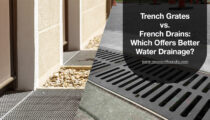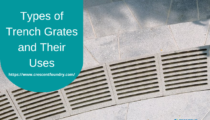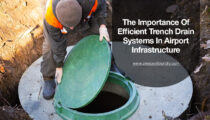Standard options for controlling water on your private property or…

The Importance of Trench Grates in Urban Infrastructure: A Comprehensive Overview
Urban infrastructure is the backbone of modern cities, facilitating the smooth functioning of daily life. Every element plays a critical role in maintaining urban order, from roads and bridges to sewage systems and drainage networks. One often overlooked but vital component of this infrastructure is trench grates. These grates, designed to cover and protect trenches, are essential in ensuring proper drainage, safety, and longevity of urban environments. In this blog, we will delve into the importance of trench grates in urban infrastructure, exploring their various applications, benefits, and the key role they play in maintaining the functionality and aesthetics of cities.
Understanding Trench Grates
Trench grates are metal or composite covers designed to span trenches or channels, allowing water and other fluids to pass through while preventing debris and larger objects from entering the drainage system. They are typically found in urban areas, industrial sites, and commercial complexes, covering drainage channels along roads, sidewalks, parking lots, and other paved surfaces. These grates are available in various materials, including cast iron, steel, aluminium, and composite materials, each offering different levels of durability, load-bearing capacity, and corrosion resistance.
The Critical Role of Trench Grates in Urban Infrastructure
- Efficient Drainage Management
One of the primary functions of trench grates is to manage surface water runoff. In urban areas, where impervious surfaces like concrete and asphalt dominate, natural water absorption is limited. Heavy rainfall can lead to water accumulation on roads, sidewalks, and other surfaces, increasing the risk of flooding. Trench grates play a crucial role in directing this excess water into the drainage system, preventing waterlogging and minimising the potential for flood-related damage.
Trench grates are particularly important in areas with high rainfall or those prone to flash floods. By ensuring efficient drainage, they help maintain the integrity of roadways and other infrastructure, reducing maintenance costs and extending their lifespan.
- Safety for Pedestrians and Vehicles
Safety is a top priority in urban design, and trench grates contribute significantly to this aspect. Open trenches or uncovered drainage channels pose a serious hazard to pedestrians, cyclists, and vehicles. Trench grates provide a protective barrier, preventing accidental falls or vehicle damage caused by exposed trenches. Additionally, they are designed to withstand heavy loads, making them suitable for installation in high-traffic areas such as roads and parking lots.
Modern trench grates are also designed with anti-slip surfaces, reducing the risk of slips and falls, especially during wet conditions. This safety feature is particularly important in pedestrian-heavy areas like sidewalks, public squares, and shopping centres.
- Aesthetic Integration with Urban Design
While functionality is the primary concern, the aesthetic impact of trench grates should not be overlooked. Urban planners and architects strive to create visually appealing environments that enhance the overall experience of city dwellers. Trench grates, when thoughtfully designed, can complement the architectural style and aesthetics of a space.
Manufacturers now offer a wide range of designs, patterns, and finishes for trench grates, allowing them to blend seamlessly with the surrounding environment. Whether it’s a modern, minimalist design for a contemporary urban setting or a more ornate pattern for a historical district, trench grates can be customised to match the aesthetic requirements of any project.
- Durability and Longevity
Urban infrastructure is subjected to constant wear and tear due to heavy usage, environmental factors, and exposure to the elements. Trench grates, being an integral part of this infrastructure, must be durable and long-lasting. The choice of material is crucial in determining the lifespan of a trench grate.
Cast iron trench grates, for example, are known for their strength and durability, making them ideal for high-traffic areas. Steel grates offer a balance between strength and weight, while aluminium grates are lightweight and resistant to corrosion. Composite grates, made from materials like fibreglass or plastic, are also gaining popularity due to their resistance to rust and chemical corrosion.
Regular maintenance and proper installation further contribute to the longevity of trench grates, ensuring they remain functional and safe for years to come.
- Environmental Considerations
In addition to their practical benefits, trench grates also play a role in environmental sustainability. By facilitating efficient drainage, they help prevent waterlogging and soil erosion, which can have detrimental effects on the urban ecosystem. Properly functioning drainage systems reduce the risk of contaminated runoff entering natural water bodies, protecting aquatic life and maintaining water quality.
Moreover, the use of recyclable materials in the manufacturing of trench grates contributes to the reduction of environmental impact. Many modern grates are made from materials that can be recycled at the end of their lifecycle, reducing waste and promoting sustainable practices.
Applications of Trench Grates in Urban Infrastructure
Trench grates are versatile and can be found in various applications across urban environments. Some of the key areas where trench grates are commonly used include:
- Roadways and Highways: Trench grates are installed along the edges of roads and highways to manage surface water runoff and prevent flooding.
- Parking Lots: In parking areas, trench grates help manage water drainage, preventing puddles and maintaining the integrity of the pavement.
- Sidewalks and Pedestrian Zones: Trench grates in pedestrian areas ensure safety by covering open trenches and preventing accidents.
- Commercial and Industrial Sites: In commercial and industrial settings, trench grates are used to cover drainage channels, ensuring efficient water management and protecting the infrastructure from damage.
- Public Spaces: Parks, plazas, and other public spaces often incorporate trench grates into their design to manage water runoff and maintain aesthetics.
Conclusion: The Integral Role of Trench Grates in Urban Planning
The importance of trench grates in urban infrastructure cannot be overstated. They are essential for effective water management, ensuring the safety of pedestrians and vehicles, and enhancing the aesthetic appeal of urban spaces. As cities continue to grow and evolve, the demand for durable, functional, and visually appealing trench grates will only increase.
For urban planners, architects, and engineers, understanding the role of trench grates in infrastructure projects is crucial. By selecting the right materials and designs, and ensuring proper installation and maintenance, they can significantly improve the functionality and longevity of urban spaces.
Crescent Foundry, with its expertise in manufacturing high-quality trench grates, is committed to providing durable and aesthetically pleasing solutions that meet the diverse needs of urban infrastructure projects. Their products ensure that cities remain safe, functional, and beautiful for generations to come.





